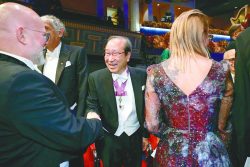
The International Space Station (ISS) photographed by Expedition 56 crew members from a Soyuz spacecraft after undocking, October 4, 2018.
17:51 JST, October 29, 2023
TOKYO (Jiji Press) — A Japanese research team said Saturday that it has succeeded in developing a fertilized mouse egg into a blastocyst, the first stage of cell differentiation, on the International Space Station.
The team includes researchers from the University of Yamanashi, the Japan Aerospace Exploration Agency, or JAXA, and government-backed research institute Riken. The result was published online in the U.S. science journal iScience.
The research comes amid heightened interest in the effects of gravity on reproduction as humanity advances into space. Although there have been cases of killifish and newts hatching in a microgravity environment, there have been few studies on mammalian reproduction due to the difficulties of breeding.
The research team, including Teruhiko Wakayama, professor at the University of Yamanashi, developed a device that allows astronauts to easily handle early mouse embryos, and sent 720 two-cell frozen mouse embryos to the ISS.
Astronaut Akihiko Hoshide, who was on a long-term mission on the ISS at the time, thawed and cultured the sent embryos for four days. Of them, 360 were cultured in a device in the Japanese Kibo experiment module that generates 1G of gravity, the same amount felt on Earth. The remaining 360 were cultured in a zero-gravity setting.
The embryos were then fixed in formalin and sent back to Earth to be compared with embryos from a similar test on Earth.
Over 60% of the embryos from the Earth test developed into blastocysts, while the rate stood at 29.5% for the embryos in the 1G space test and 23.6% for the zero-gravity test.
In the blastocyst stage, cells differentiate for the first time into inner cell mass cells, which later become the fetus, and trophectoderm cells, which later become the placenta.
The experiment found that the differentiations, rate of DNA damage and gene expressions of blastocysts developed in zero-gravity did not differ from those in other settings.
It also found that the inner cell mass cells in three of the 12 blastocysts from the zero-gravity test examined in detail clustered in two places, instead of the usual one. Such blastocysts have the possibility of developing into identical monozygotic twins.
“We found that, even under zero-gravity conditions, embryos develop normally until they reach the blastocyst stage,” Wakayama said. “In the case of mammals, we need to examine whether they will implant and grow properly.”
"Science & Nature" POPULAR ARTICLE
-

Mass Oyster Die-Offs Confirmed in Japan’s Seto Inland Sea; High Water Temperature Cited as Primary Cause
-

Genome Study Reveals Milestone in History of Cat Domestication
-

Big Leap in Quest to Get to Bottom of Climate Ice Mystery
-

Security Camera Footage Vulnerable to Outside Access; Investigation Finds 3,000 Pieces Exposed Online
-

Paws on Parade: Nairobi’s Dogs Dazzle at ‘Pawchella’
JN ACCESS RANKING
-

Keidanren Chairman Yoshinobu Tsutsui Visits Kashiwazaki-Kariwa Nuclear Power Plant; Inspects New Emergency Safety System
-

Imports of Rare Earths from China Facing Delays, May Be Caused by Deterioration of Japan-China Relations
-

University of Tokyo Professor Discusses Japanese Economic Security in Interview Ahead of Forum
-

Japan Pulls out of Vietnam Nuclear Project, Complicating Hanoi’s Power Plans
-

Govt Aims to Expand NISA Program Lineup, Abolish Age Restriction
























